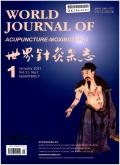Effects of direct moxibustion on antigen-presenting cells in gastric tissue of rat models with gastric cancer: Understanding the immunological mechanisms
IF 1.3
4区 医学
Q4 INTEGRATIVE & COMPLEMENTARY MEDICINE
引用次数: 0
Abstract
Objective
The preventive and therapeutic effects of direct moxibustion on a gastric cancer rat model induced by the intragastric administration of N-methyl-N'-nitro-N-nitrosoguanidine (MNNG) were evaluated. Changes in the co-stimulatory molecules CD80 and CD86 on antigen-presenting cells in gastric tissues as well as related cytokines in serum were evaluated. The aim of the study was to explore the immunological mechanisms by which direct moxibustion may prevent gastric cancer lesions, thereby providing a basis for studies on the immunological mechanisms by which moxibustion prevents tumor development.
Methods
Sixty healthy male Wistar rats were randomly divided into four groups: Control, control+moxibustion, model, and moxibustion groups. A gastric cancer rat model was induced by intragastric administration of 20 mg/mL MNNG, with a dose of 1 mL/100 g body weight, once daily for 16 weeks. The control+moxibustion and moxibustion groups received direct moxibustion simultaneously with modeling, continuing for 16 weeks. After the experiment, gastric tissue was collected, and morphological changes in the gastric mucosa in each group of rats were observed through H&E staining. Immunohistochemistry (IHC) and a western blotting were used to detect the expression levels of CD80 and CD86 in gastric tissues. Enzyme-linked immunosorbent assays (ELISA) were used to measure the levels of interleukin-12 (IL-12), interferon-gamma (IFN-γ), and tumor necrosis factor-beta (TNF-β) in rat serum.
Results
Upon macroscopic observation, the gastric mucosa of rats in the control and control+moxibustion groups appeared uniformly red, with a glossy mucosal surface, normal gastric wall elasticity, and clear, regular mucosal folds, without hyperplasia or bleeding points. In the model group, the gastric mucosa was reduced in volume, the gastric wall thinned, elasticity decreased, mucosal folds were disordered, and yellow-white cauliflower-like lesions and yellow-brown hyperkeratosis were observed. In the moxibustion group, the gastric mucosa showed decreased elasticity, with disordered mucosal folds and granular hyperplasia. After H&E staining, the gastric mucosal structure was clear and intact in the control and control+moxibustion groups displaying an organized and uniform arrangement of the mucosa, submucosa, and muscularis propria, without hyperplasia or keratinization. In the model group, the epithelial glands in the gastric mucosa were disordered, with varied cell morphologies, thickened submucosa, and disrupted squamous epithelium that invaded downward into the muscularis propria. In the moxibustion group, the squamous epithelium did not invade the muscularis propria. IHC results showed higher expression levels of CD80 and CD86 in the gastric mucosa of the control+moxibustion group than in the control group (P < 0.05) and lower expression levels in the model group than in the control group (P < 0.05). The moxibustion group showed higher CD80 and CD86 levels than those in the model group (P < 0.05). Western blotting indicated that CD80 and CD86 levels were higher in the moxibustion group than in the model group (P < 0.05). ELISA results showed higher IL-12 levels in the model group than in the control group (P < 0.05) and higher TNF-β and IFN-γ levels in the moxibustion group than in the model group (P < 0.01).
Conclusion
Direct moxibustion alleviates the pathological progression of gastric cancer in an MNNG-induced rat model. Its mechanisms may involve effects on the state of antigen-presenting cells, thereby promoting T cell activation and enhancing immune function.
直接艾灸对胃癌模型大鼠胃组织抗原呈递细胞的影响及其免疫学机制的探讨
目的观察直接艾灸对胃灌胃n -甲基-n '-硝基-n -亚硝基胍(MNNG)诱导的胃癌大鼠模型的防治作用。观察胃组织抗原提呈细胞的共刺激分子CD80、CD86及血清中相关细胞因子的变化。本研究旨在探讨直接艾灸预防胃癌病变的免疫学机制,为艾灸预防肿瘤发生的免疫学机制的研究提供基础。方法健康雄性Wistar大鼠60只,随机分为4组:对照组、对照组+艾灸组、模型组和艾灸组。采用MNNG灌胃20 mg/mL,剂量为1 mL/100 g体重,每日1次,连续16周建立胃癌大鼠模型。对照组+艾灸组和艾灸组在造模的同时直接艾灸,持续16周。实验结束后采集胃组织,通过H&;E染色观察各组大鼠胃黏膜形态学变化。采用免疫组化(IHC)和western blotting检测CD80和CD86在胃组织中的表达水平。采用酶联免疫吸附法(ELISA)测定大鼠血清中白细胞介素-12 (IL-12)、干扰素-γ (IFN-γ)和肿瘤坏死因子-β (TNF-β)的水平。结果肉眼观察,对照组和对照组+艾灸组大鼠胃黏膜呈均匀红色,粘膜表面光滑,胃壁弹性正常,粘膜褶皱清晰、规则,无增生、无出血点。模型组大鼠胃黏膜体积缩小,胃壁变薄,弹性降低,粘膜褶皱紊乱,出现黄白色花椰菜样病变和黄棕色角化过度。艾灸组胃黏膜弹性降低,黏膜褶皱紊乱,颗粒增生。H&;E染色后,对照组和对照组+艾灸组胃黏膜结构清晰完整,黏膜、黏膜下层、固有肌层排列整齐均匀,未见增生、角化。模型组大鼠胃黏膜上皮腺结构紊乱,细胞形态变化,黏膜下层增厚,鳞状上皮破坏,向下侵入固有肌层。艾灸组鳞状上皮未侵犯固有肌层。免疫组化结果显示,对照组+艾灸组胃黏膜CD80和CD86表达水平高于对照组(P <;0.05),且模型组的表达水平低于对照组(P <;0.05)。艾灸组CD80、CD86水平明显高于模型组(P <;0.05)。免疫印迹检测结果显示,艾灸组CD80、CD86水平明显高于模型组(P <;0.05)。ELISA结果显示,模型组大鼠IL-12水平高于对照组(P <;0.05),且艾灸组TNF-β、IFN-γ水平高于模型组(P <;0.01)。结论直接艾灸可减轻mnng诱导大鼠胃癌的病理进展。其机制可能涉及影响抗原提呈细胞状态,从而促进T细胞活化,增强免疫功能。
本文章由计算机程序翻译,如有差异,请以英文原文为准。
求助全文
约1分钟内获得全文
求助全文
来源期刊

World Journal of Acupuncture-Moxibustion
INTEGRATIVE & COMPLEMENTARY MEDICINE-
CiteScore
1.30
自引率
28.60%
发文量
1089
审稿时长
50 days
期刊介绍:
The focus of the journal includes, but is not confined to, clinical research, summaries of clinical experiences, experimental research and clinical reports on needling techniques, moxibustion techniques, acupuncture analgesia and acupuncture anesthesia.
 求助内容:
求助内容: 应助结果提醒方式:
应助结果提醒方式:


